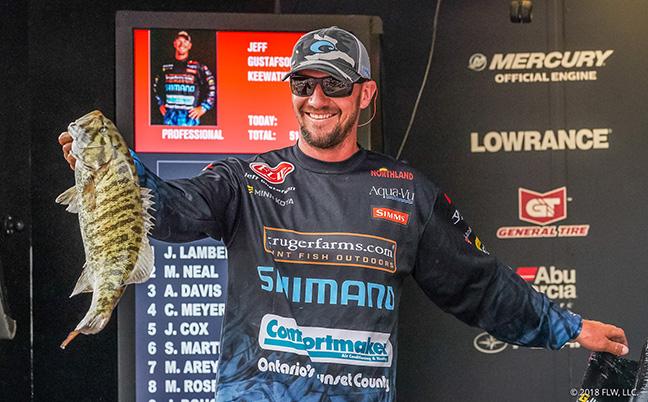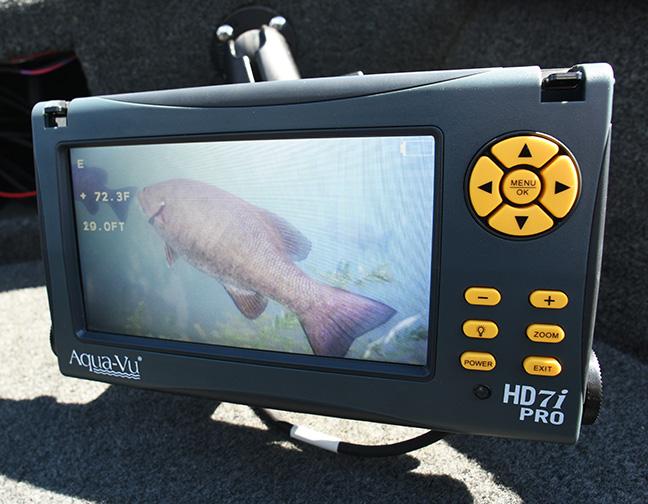
Crosslake, Minn. Anyone who’s fished North America’s best bass lakes in recent seasons has seen the signs: Clearing waters; schools of trophy bass shifting deeper and deeper; tournament game plans revolving around off-shore structure, anglers mining small, specific sections of underwater real estate.
For Jeff “Gussy” Gustafson—the popular, successful FLW Tour bass pro—probing deep water has long ranked high among his impressive set of fishing skills. Beginning almost two decades ago, Gussy launched an incredible string of tournament wins, taking the title at Canada’s most prestigious bass tournament, the Kenora Bass International in 2000. He won the event again in 2008, along with partner Chris Savage. In 2005, Gustafson and partner Scott Dingwall won the inaugural International Falls Bass Championship—another highly competitive bass event that attracts a who’s-who list of elite-level anglers.
Gustafson and Dingwall won the two-day I-Falls Bass Championship for an unprecedented fifth time, extracting 40-pounds of smallmouth bass from small, deepwater sweet spots. “In the summer, almost every hump on Rainy Lake has walleyes on it,” noted Gustafson, ranked #11 in the FLW Tour’s Angler of the Year race. “But only certain spots hold big smallmouths.
“While scouting for bass in prefishing, down imaging sonar helped tell part of the story, but we relied on the optics of my Aqua-Vu HD7i Pro underwater camera to show us what species was living on each spot. In our three days of practice,” Gustafson recounted, “we spent a lot of time idling around looking at fish on different spots.
“The camera showed us that the bass seemed to be in groups of five to eight fish, hanging slightly higher off bottom than the walleyes. It was an efficient method of searching because one of us could run the trolling motor and the other guy could scope with the Aqua-Vu. We could get super accurate by going over exact waypoints where we marked fish, drop the camera and get instant species verification—as well as seeing fish size and where they were set up relative to the rocks.”

Gustafson and Dingwall, who bagged over 20-pounds of smallmouths each of the two tournament days, fished a one-two punch of presentations. “We felt our chances of catching four pound smallmouths were better fishing deep than working the banks,” noted Gussy, who’s earned renown on the FLW Tour for his ability to locate big bass away from the banks. “We caught our fish on a variety of baits, including swimbaits, hair jigs and tubes like the Impulse Fatty Tube. We would cast over spots first with fast-moving baits and then follow up in slow-down mode with the tube.
“In the tournament, we were able to return to the few spots where we’d scoped big smallmouths hanging around and pluck a few of them off,” he said. “Having the confidence to fish slow on some of the spots was huge, because we knew they were holding four pounders.”

A common, though rarely talked-about tool in bass tournament boats for at least the past decade, Aqua-Vu cameras are now acknowledged as key fish-finding tools by anglers such as Gustafson and Bassmaster Elite Series pro Ott DeFoe. For DeFoe, concealing the camera within boat storage is no longer an option, as his newest high-definition version is mounted to the deck of his Nitro bass boat, right beside other electronics.
After his third 2018 visit to the St. Lawrence River—a late August Bassmaster Elite Series event—DeFoe called out a key advantage provided of his Aqua-Vu. “Those fish on the St. Lawrence sit so tight to the rocks, that even with my space-age Humminbird graphs, I couldn’t always pick them out,” he said. “But the underwater camera leaves nothing to doubt. After dropping the optics, I could see the fish clear as day. It gave me the confidence to stay and fish. I was able to execute the right drift, angle and speed and eventually boated a smallmouth over 4 pounds and another at almost three.
“The good and bad about using a camera,” DeFoe laughs, “is that it finds them with 100-percent certainty, but doesn’t guarantee they’ll bite.”
Which might still be better than fishing for the “wrong” species. Gustafson, who in May placed 7th out of 180 anglers at the FLW Tour derby on Kentucky Lake, discovered another key use for his Aqua-Vu. “We used to mark fish on our graphs on this lake and you could just about guarantee they were bass,” he reflected. “Now, the lake is absolutely infested with Asian carp. You mark a lot of fish that look just like bass on sonar, and you can waste tons of time casting to fish that are actually carp. Instead, I was able to lower the camera around these ledges where I was marking a lot of fish and see immediately whether they were bass or carp.”
Similarly, in brushpiles, flooded timber and even beneath boat docks, Gussy says his Aqua-Vu gives him the advantage of verifying with total accuracy the presence of target species versus alternative fish.
Previously considered a useful tool in deepwater only, Gussy recently found a new use for his underwater camera. “I’ve just started experimenting with a telescopic pole attachment Aqua-Vu makes that probes under docks and shallow cover. Pretty cool to see where bass position beneath docks and exactly what the support beams and other structures look like. Really helps me pinpoint the sweet spots with casts on tournament day.
“That’s the whole key to this tool—I don’t need to catch them during prefishing, I just need to see them. If I can go into a tournament with foreknowledge of bass location, I’m already ahead of the game.”

